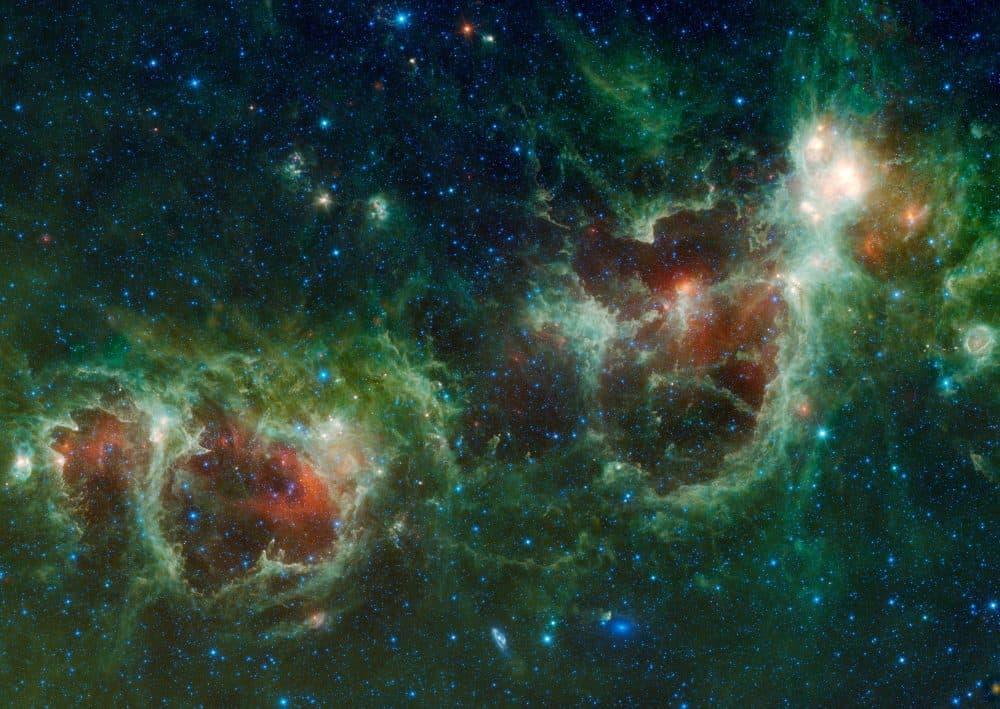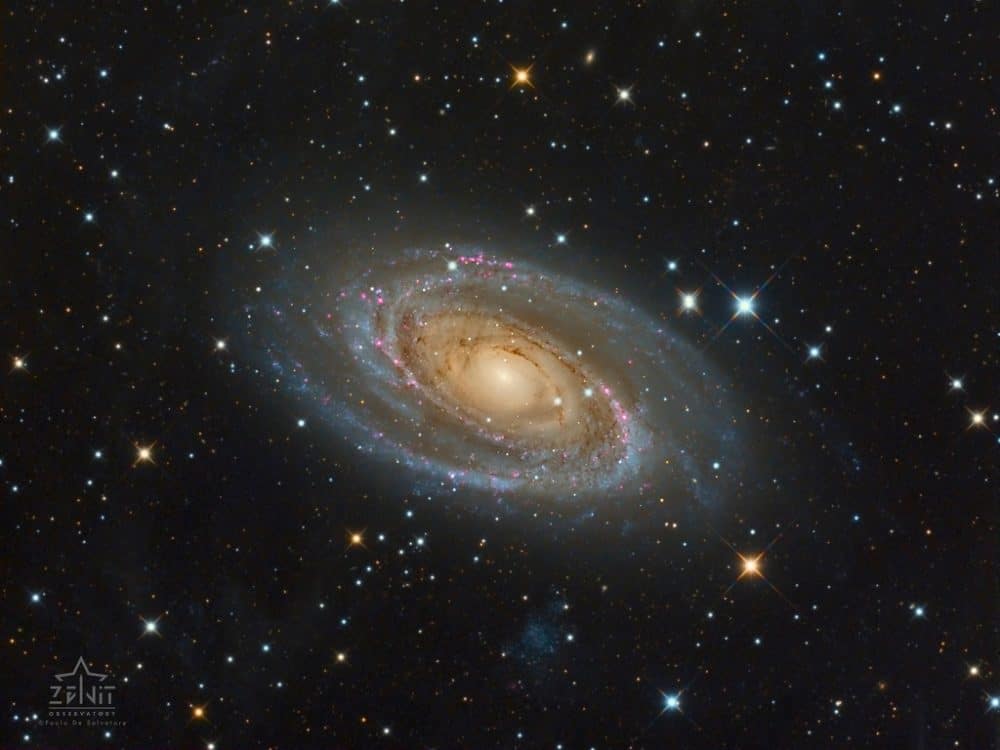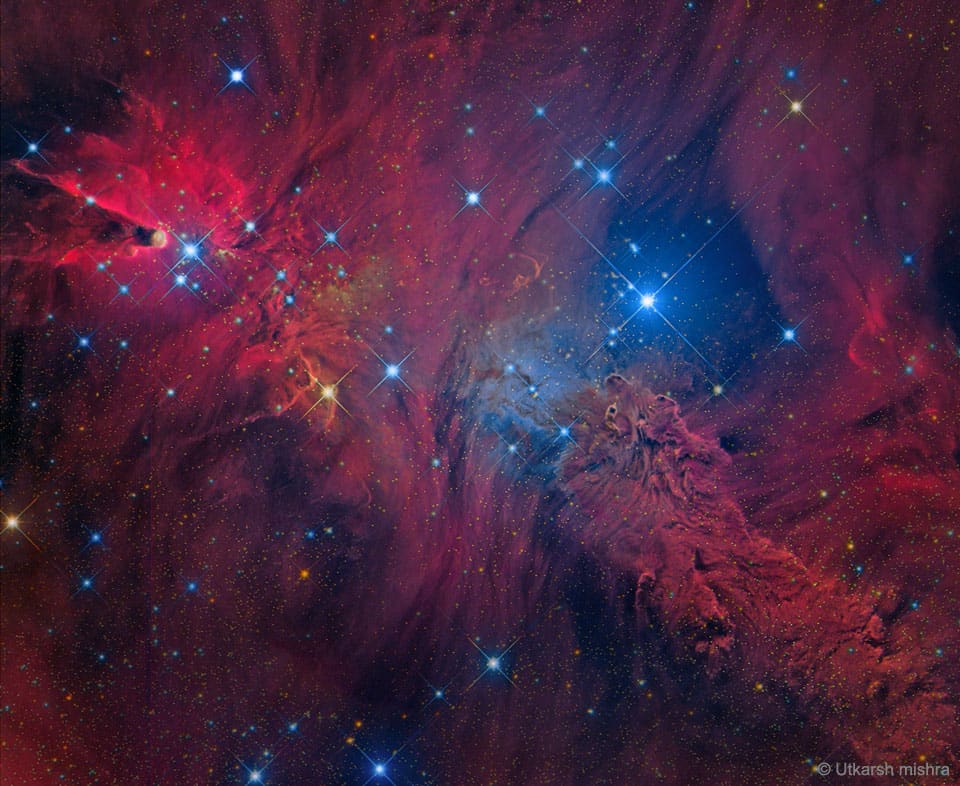Blog
The Heart and Soul nebulae are seen in this infrared mosaic from NASA’s Wide-field Infrared Survey Explorer, or WISE. The image covers an area of the sky over ten times as wide as the full moon and eight times as high (5.5 x 3.9 degrees) in the constellation Cassiopeia.
Located about 6,000 light-years from Earth, the Heart and Soul nebulae form a vast star-forming complex that makes up part of the Perseus spiral arm of our Milky Way galaxy. The nebula to the right is the Heart, designated IC 1805 and named after its resemblance to a human heart. To the left is the Soul nebula, also known as the Embryo nebula, IC 1848 or W5. The Perseus arm lies further from the center of the Milky Way than the arm that contains our sun. The Heart and Soul nebulae stretch out nearly 580 light-years across, covering a small portion of the diameter of the Milky Way, which is roughly 100,000 light-years across.
The two nebulae are both massive star-making factories, marked by giant bubbles that were blown into surrounding dust by radiation and winds from the stars. WISE’s infrared vision allows it to see into the cooler and dustier crevices of clouds like these, where gas and dust are just beginning to collect into new stars. These stars are less than a few million of years old — youngsters in comparison to stars like the sun, which is nearly 5 billion years old.
Also visible near the bottom of this image are two galaxies, Maffei 1 and Maffei 2. Both galaxies contain billions of stars and, at about 10 million light-years away, are well outside our Milky Way yet relatively close compared to most galaxies. Maffei 1 is the bluish elliptical object and Maffei 2 is the spiral galaxy.
All four infrared detectors aboard WISE were used to make this image. Color is representational: blue and cyan represent infrared light at wavelengths of 3.4 and 4.6 microns, which is dominated by light from stars. Green and red represent light at 12 and 22 microns, which is mostly light from warm dust.
more...George Bernard “Bernie” Worrell, Jr. (April 19, 1944 – June 24, 2016) was an American keyboardist and composer best known as a founding member of Parliament-Funkadelicand for his work with Talking Heads. He is a member of the Rock and Roll Hall of Fame, inducted in 1997 with fifteen other members of Parliament-Funkadelic. Worrell was described by Jon Pareles of The New York Times as “the kind of sideman who is as influential as some bandleaders.”
Worrell was born in Long Branch, New Jersey, and grew up in Plainfield, New Jersey, where his family moved when he was eight.[1] A musical prodigy, he began formal piano lessons by age three and wrote a concerto at age eight. He went on to study at the Juilliard School and received a degree from the New England Conservatory of Music in 1967. As a college student, Worrell played with a group called Chubby & The Turnpikes; this ensemble eventually evolved into Tavares.
After meeting George Clinton, leader of a Plainfield-based doo wop group called The Parliaments, Worrell, Clinton, The Parliaments and their backing band, The Funkadelics, moved to Detroit, Michigan; thereafter, both groups became collectively known as Parliament-Funkadelic. During the 1970s the same group of musicians separately recorded under the names Parliament and Funkadelic, (among several others), but toured as P-Funk. Worrell played grand piano, Wurlitzer electric piano, Hohner Clavinet, Hammond B3 organ, ARP String Ensemble and Moog synthesizer, co-wrote, and wrote horn and rhythm arrangements on hit recordings for both groups and other associated bands under the “Parliafunkadelicment Thang” production company, and many of his most notable performances were recorded with Bootsy’s Rubber Band, Parlet, The Brides of Funkenstein and The Horny Horns. Worrell recorded a 1978 solo album, All the Woo in the World, with the musical backing of P-Funk’s members.
more...Dudley Stuart John Moore, CBE (19 April 1935 – 27 March 2002) was an English actor, comedian, musician and composer.
Moore first came to prominence in the UK as one of the four writer-performers in the comedy revue Beyond the Fringe from 1960, and with one member of that team, Peter Cook, collaborated on the television series Not Only… But Also. The double act worked on other projects until the mid-1970s, by which time Moore had settled in Los Angeles to concentrate on his film acting.
His solo career as a comedy film actor was heightened by the success of hit Hollywood films, particularly Foul Play (1978), 10 (1979) and Arthur (1981). For Arthur, Moore was nominated for the Academy Award for Best Actor and won a Golden Globe Award. He received a second Golden Globe for his performance in Micki & Maude (1984).
more...Flamenco Fridays with Fandango. The current 3/4 pattern of the fandango, its distinctive progression (i–iv–V) lyrics with octosyllabic verses and the use of castanets and guitars are well-documented from the 18th century.
The fandangos grandes (big fandangos) are normally danced by couples, which start out slowly with gradually increasing tempo. Many varieties are derived from this one.
The fandanguillos (little fandangos) are livelier, more festive derivations of fandangos. Some regions of Spain have developed their own style of fandangos, such as Huelva (fandangos de Huelva) and Málaga (fandangos de Málaga, or Verdiales). Northern areas such as the Principality of Asturias, the Basque Country and Castile and León have preserved a more relaxed performance.
more...Voices of Sepharad on Maundy Thursday 4-18-19
Washing of the Feet Celebration for Easter Week
Voices of Sepharad performing Maundy Thursday at Westminster Presbyterian in Westminster Hall in the new section 530-630pm
with David Harris, David Burk and the undavid mick laBriola
https://www.westminstermpls.org
Discovered in 1784 by the German–British astronomer William Herschel, NGC 4394 is a barred spiral galaxy situated about 55 million light-years from Earth. The galaxy lies in the constellation of Coma Berenices (Berenice’s Hair) and is considered to be a member of the Virgo Cluster.
NGC 4394 is the archetypal barred spiral galaxy, with bright spiral arms emerging from the ends of a bar that cuts through the galaxy’s central bulge. These arms are peppered with young blue stars, dark filaments of cosmic dust, and bright, fuzzy regions of active star formation. At the center of NGC 4394 lies a region of ionized gas known as a low-ionization nuclear emission-line region (LINER). LINERs are active regions that display a characteristic set of emission lines in their spectra— mostly from weakly ionized atoms of oxygen, nitrogen and sulphur.
Although LINER galaxies are relatively common, it’s still unclear where the energy comes from to ionize the gas. In most cases it is thought to be the influence of a black hole at the center of the galaxy, but it could also be the result of a high level of star formation. In the case of NGC 4394, it is likely that gravitational interaction with a nearby neighbor has caused gas to flow into the galaxy’s central region, providing a new reservoir of material to fuel the black hole or to make new stars.
more...Clyde Austin Stubblefield (April 18, 1943 – February 18, 2017) was an American drummer best known for his work with James Brown. A self-taught musician, he was influenced by the sound of natural rhythms around him. His drum patterns on Brown’s recordings are considered funk standards. He recorded and toured with Brown for six years and settled in Madison, Wisconsin, where he was a staple of the local music scene. Often uncredited, samples of his drum patterns were heavily used in hip hop music. He was the recipient of an honorary doctorate in fine arts.
Born to Frank D. and Vena Stubblefield on April 18, 1943, he grew up in Chattanooga, Tennessee. He was inspired to pursue drumming after seeing drummers for the first time in a parade. As a youngster his sense of rhythm was influenced by the industrial sounds of factories and trains around him. He practiced the rhythm patterns he heard, sometimes playing two rhythms together. Years later he said about his drumming approach, “If I think of something (…) if I can hum it, I can play it.” He played professionally as a teenager and performed in local bands such as Blue Shufflers, Inclines, and Cascades.
more...Clarence “Gatemouth” Brown (April 18, 1924 – September 10, 2005) was an American musician from Louisiana and Texas known for his work as a blues musician, as well as other styles of music. He spent his career fighting purism by synthesizing old blues, country, jazz, Cajun music and R&B styles. His work also encompasses rock and roll, rock music, folk music, electric blues, and Texas blues.
He was an acclaimed multi-instrumentalist, who played an array of musical instruments, including the guitar, fiddle, mandolin, viola, harmonica and drums. He won a Grammy Award for Best Traditional Blues Album in 1983 for his album, Alright Again!. He is regarded as one of the most influential exponents of blues fiddle and has had enormous influence in American fiddlecircles.
Brown’s two biggest musical influences were Louis Jordan and T-Bone Walker.
Brown was born in Vinton, Louisiana, and raised in Orange, Texas. His professional music career began in 1945, playing drums in San Antonio, Texas.
more...Eurreal Wilford “Little Brother” Montgomery (April 18, 1906 – September 6, 1985) was an American jazz, boogie-woogie and blues pianist and singer.
Largely self-taught, Montgomery was an important blues pianist with an original style. He was also versatile, working in jazz bands, including larger ensembles that used written arrangements. He did not read music but learned band routines by ear—once through an arrangement and he had it memorized.
Montgomery was born in Kentwood, Louisiana, United States, a sawmill town near the Mississippi border, across Lake Pontchartrain from New Orleans, where he spent much of his childhood. Both his parents were of African-American and Creek Indian ancestry. As a child he looked like his father, Harper Montgomery, and was called Little Brother Harper. The name evolved into Little Brother Montgomery, and the nickname stuck. He started playing piano at the age of 4, and by age 11 he was playing at barrelhouses in Louisiana. His main musical influence was Jelly Roll Morton, who used to visit the Montgomery household.
more...One of the brightest galaxies in planet Earth’s sky is similar in size to our Milky Way Galaxy: big, beautiful Messier 81. Also known as NGC 3031 or Bode’s galaxy for its 18th century discoverer, this grand spiral can be found toward the northern constellation of Ursa Major, the Great Bear. The detailed telescopic view reveals M81’s bright yellow nucleus, blue spiral arms, pink starforming regions, and sweeping cosmic dust lanes. Some dust lanes actually run through the galactic disk (left of center), contrary to other prominent spiral features though. The errant dust lanes may be the lingering result of a close encounter between M81 and its smaller companion galaxy, M82. Scrutiny of variable stars in M81 has yielded one of the best determined distances for an external galaxy — 11.8 million light-years.
more...Jan Hammer (Czech pronunciation: [ˈjan ˈɦamɛr]) (born 17 April 1948) is a Czech-American musician, composer and record producer. He first gained his most visible audience while playing keyboards with the Mahavishnu Orchestra in the early 1970s, as well as his film scores for television and film including “Miami Vice Theme” and “Crockett’s Theme“, from the 1980s television program, Miami Vice. He has continued to work as both a musical performer and producer, expanding to producing film later in his career.
Hammer has collaborated with some of the era’s most influential jazz and rock musicians such as John McLaughlin, Jeff Beck, Al Di Meola, Mick Jagger, Carlos Santana, Stanley Clarke, Tommy Bolin, Neal Schon, Steve Lukather and Elvin Jones. He has composed and produced at least 14 original motion picture soundtracks, the music for 90 episodes of Miami Vice and 20 episodes of the television series Chancer.
His compositions have won him several Grammy Awards. Jan Hammer was born in Prague, then capital of Czechoslovakia (now the Czech Republic).
Charles Anthony “Buster” Williams (born April 17, 1942 in Camden, New Jersey) is an American jazz bassist. Williams is known for his membership in pianist Herbie Hancock‘s early 1970s group, working with guitarist Larry Coryell from the 1980s to present, working in the Thelonious Monk repertory band Sphere and as the accompanist of choice for many singers, including Nancy Wilson. Williams’ father, Charles Anthony Williams, Sr., was a musician who played bass, drums, and piano, and had band rehearsals in the family home in Camden, New Jersey, exposing Williams to jazz at an early age. Williams was particularly inspired to focus on bass after hearing his father’s record of Star Dust, performed by Oscar Pettiford, and started playing in his early teens.
In October 1968, Williams moved to New York City and continued to work steadily, playing shows with Art Blakey, Herbie Mann, and Mary Lou Williams, while recording for Atlantic, Blue Note, and Prestige with artists such as McCoy Tyner, Dexter Gordon, Roy Ayers, Stanley Turrentine, Frank Foster, Illinois Jacquet, and, once again, Gene Ammons (recently returned from a seven-year stint in Joliet). Having worked with Herbie Hancock in the Miles Davis Quintet, Williams became a fixture of Hancock’s Mwandishi Sextet, recording three albums for Warner Bros., Sextant for Columbia, The Prisoner for Blue Note, and two more under Eddie Henderson‘s name for Capricorn. The Mwandishi Sextet explored new electronic sounds in jazz and featured Williams on both acoustic and electric bass.
https://www.youtube.com/watch?v=xWYiwyMsqFc
more...Strange shapes and textures can be found in neighborhood of the Cone Nebula. The unusual shapes originate from fine interstellar dust reacting in complex ways with the energetic light and hot gas being expelled by the young stars. The brightest star on the right of the featured picture is S Mon, while the region just below it has been nicknamed the Fox Fur Nebula for its color and structure. The blue glow directly surrounding S Mon results from reflection, where neighboring dust reflects light from the bright star. The red glow that encompasses the whole region results not only from dust reflection but also emission from hydrogengas ionized by starlight. S Mon is part of a young open cluster of stars named NGC 2264, located about 2500 light years away toward the constellation of the Unicorn (Monoceros). Even though it points right at S Mon, details of the origin of the mysterious geometric Cone Nebula, visible on the far left, remain a mystery.
more...Herbert Jay Solomon (April 16, 1930 – July 1, 2003), known by his stage name Herbie Mann, was an American jazz flutist and important early practitioner of world music. Early in his career, he also played tenor saxophone and clarinet (including bass clarinet), but Mann was among the first jazz musicians to specialize on the flute. His most popular single was “Hijack“, which was a Billboard No. 1 dance hit for three weeks in 1975.
Mann emphasized the groove approach in his music. Mann felt that from his repertoire, the “epitome of a groove record” was Memphis Underground or Push Push, because the “rhythm section locked all in one perception.”Herbie Mann was born in Brooklyn, New York, to Jewish parents, Harry C. Solomon (May 30, 1902 – May 31, 1980), who was of Russian descent, and Ruth Rose Solomon (née Brecher) (July 4, 1905 – November 11, 2004), of Romanian descent who was born in Bukovina, Austria-Hungary but immigrated to the United States with her family at the age of 6.
John Wesley Funchess (April 16, 1931 – February 1, 1994) known professionally as John (or Johnny) Littlejohn, was an American electric blues slide guitarist. He was active on the Chicago blues circuit from the 1950s to the 1980s. Born in Lake, Mississippi, Littlejohn first learned to play the blues from Henry Martin, a friend of his father’s. In 1946 he left home and traveled widely, spending time in Jackson, Mississippi; Arkansas; Rochester, New York; and Gary, Indiana. He settled in Gary in 1951, playing whenever possible in the nearby Chicago area. Through his connections in Gary, he was acquainted with Joe Jackson, the patriarch of the musical Jackson family, and Littlejohn and his band reputedly served as an occasional rehearsal band for the Jackson 5 in the mid- to late 1960s.
Littlejohn played regularly in Chicago clubs (he was filmed by drummer Sam Lay playing with Howlin’ Wolf‘s band about 1961) but did not make any studio recordings until 1968, when he cut singles for several record labels. Later that year he recorded an album for Arhoolie Records and four songs for Chess Records. The Chess tracks were not issued at the time.
more...More Posts
- Rita Marley
- Don Ellis
- Johnny Hodges
- World Music Kommuna Lux
- Daily Roots Augustus Pablo
- Cosmos UGC 12295
- Graham Lear
- Charles McPherson
- Billy Taylor
- World Music The Funkees
- Daily Roots Barrington Levy
- JEWBALAYA August 6th & 13th 2023
- A Chorus Line by Theatre 55 Last Performance
- Cosmos Mandel Wilson 9
- Bill Lee
- Steve Lacy
- “Champion Jack” Dupree
- World Music Tinariwen
- Daily Roots Jacob Miller
- A Chorus Line by Theatre 55



